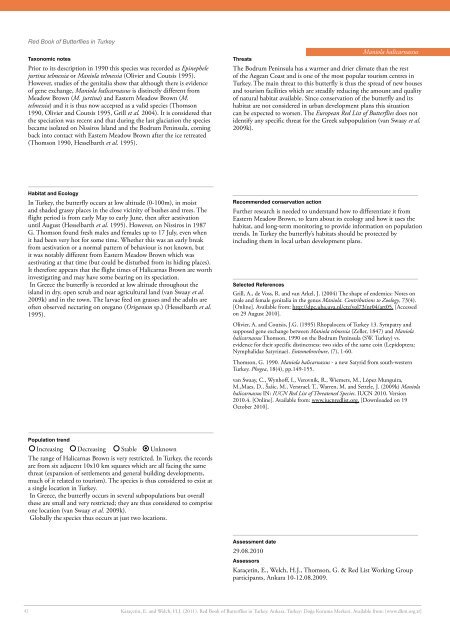Red Book of Butterflies in Turkey Red Book of Butterflies in Turkey
Red Book of Butterflies in Turkey Red Book of Butterflies in Turkey
Red Book of Butterflies in Turkey Red Book of Butterflies in Turkey
You also want an ePaper? Increase the reach of your titles
YUMPU automatically turns print PDFs into web optimized ePapers that Google loves.
<strong>Red</strong> <strong>Book</strong> <strong>of</strong> <strong>Butterflies</strong> <strong>in</strong> <strong>Turkey</strong><br />
Taxonomic notes<br />
Prior to its description <strong>in</strong> 1990 this species was recorded as Ep<strong>in</strong>ephele<br />
jurt<strong>in</strong>a telmessia or Maniola telmessia (Olivier and Coutsis 1995).<br />
However, studies <strong>of</strong> the genitalia show that although there is evidence<br />
<strong>of</strong> gene exchange, Maniola halicarnassus is dist<strong>in</strong>ctly different from<br />
Meadow Brown (M. jurt<strong>in</strong>a) and Eastern Meadow Brown (M.<br />
telmessia) and it is thus now accepted as a valid species (Thomson<br />
1990, Olivier and Coutsis 1995, Grill et al. 2004). It is considered that<br />
the speciation was recent and that dur<strong>in</strong>g the last glaciation the species<br />
became isolated on Nissiros Island and the Bodrum Pen<strong>in</strong>sula, com<strong>in</strong>g<br />
back <strong>in</strong>to contact with Eastern Meadow Brown after the ice retreated<br />
(Thomson 1990, Hesselbarth et al. 1995).<br />
Habitat and Ecology<br />
In <strong>Turkey</strong>, the butterfly occurs at low altitude (0-100m), <strong>in</strong> moist<br />
and shaded grassy places <strong>in</strong> the close vic<strong>in</strong>ity <strong>of</strong> bushes and trees. The<br />
flight period is from early May to early June, then after aestivation<br />
until August (Hesselbarth et al. 1995). However, on Nissiros <strong>in</strong> 1987<br />
G. Thomson found fresh males and females up to 17 July, even when<br />
it had been very hot for some time. Whether this was an early break<br />
from aestivation or a normal pattern <strong>of</strong> behaviour is not known, but<br />
it was notably different from Eastern Meadow Brown which was<br />
aestivat<strong>in</strong>g at that time (but could be disturbed from its hid<strong>in</strong>g places).<br />
It therefore appears that the flight times <strong>of</strong> Halicarnas Brown are worth<br />
<strong>in</strong>vestigat<strong>in</strong>g and may have some bear<strong>in</strong>g on its speciation.<br />
In Greece the butterfly is recorded at low altitude throughout the<br />
island <strong>in</strong> dry, open scrub and near agricultural land (van Swaay et al.<br />
2009k) and <strong>in</strong> the town. The larvae feed on grasses and the adults are<br />
<strong>of</strong>ten observed nectar<strong>in</strong>g on oregano (Origanum sp.) (Hesselbarth et al.<br />
1995).<br />
Increas<strong>in</strong>g Decreas<strong>in</strong>g Stable Unknown<br />
The range <strong>of</strong> Halicarnas Brown is very restricted. In <strong>Turkey</strong>, the records<br />
are from six adjacent 10x10 km squares which are all fac<strong>in</strong>g the same<br />
threat (expansion <strong>of</strong> settlements and general build<strong>in</strong>g developments,<br />
much <strong>of</strong> it related to tourism). The species is thus considered to exist at<br />
a s<strong>in</strong>gle location <strong>in</strong> <strong>Turkey</strong>.<br />
In Greece, the butterfly occurs <strong>in</strong> several subpopulations but overall<br />
these are small and very restricted; they are thus considered to comprise<br />
one location (van Swaay et al. 2009k).<br />
Globally the species thus occurs at just two locations.<br />
42<br />
Population trend<br />
Maniola halicarnassus<br />
Threats<br />
The Bodrum Pen<strong>in</strong>sula has a warmer and drier climate than the rest<br />
<strong>of</strong> the Aegean Coast and is one <strong>of</strong> the most popular tourism centres <strong>in</strong><br />
<strong>Turkey</strong>. The ma<strong>in</strong> threat to this butterfly is thus the spread <strong>of</strong> new houses<br />
and tourism facilities which are steadily reduc<strong>in</strong>g the amount and quality<br />
<strong>of</strong> natural habitat available. S<strong>in</strong>ce conservation <strong>of</strong> the butterfly and its<br />
habitat are not considered <strong>in</strong> urban development plans this situation<br />
can be expected to worsen. The European <strong>Red</strong> List <strong>of</strong> <strong>Butterflies</strong> does not<br />
identify any specific threat for the Greek subpopulation (van Swaay et al.<br />
2009k).<br />
Recommended conservation action<br />
Further research is needed to understand how to differentiate it from<br />
Eastern Meadow Brown, to learn about its ecology and how it uses the<br />
habitat, and long-term monitor<strong>in</strong>g to provide <strong>in</strong>formation on population<br />
trends. In <strong>Turkey</strong> the butterfly’s habitats should be protected by<br />
<strong>in</strong>clud<strong>in</strong>g them <strong>in</strong> local urban development plans.<br />
Selected References<br />
Grill, A., de Voss, R. and van Arkel, J. (2004) The shape <strong>of</strong> endemics: Notes on<br />
male and female genitalia <strong>in</strong> the genus Maniola. Contributions to Zoology, 73(4).<br />
[Onl<strong>in</strong>e]. Available from: http://dpc.uba.uva.nl/ctz/vol73/nr04/art05. [Accessed<br />
on 29 August 2010].<br />
Olivier, A. and Coutsis, J.G. (1995) Rhopalocera <strong>of</strong> <strong>Turkey</strong> 13. Sympatry and<br />
supposed gene exchange between Maniola telmessia (Zeller, 1847) and Maniola<br />
halicarnassus Thomson, 1990 on the Bodrum Pen<strong>in</strong>sula (SW. <strong>Turkey</strong>) vs.<br />
evidence for their specific dist<strong>in</strong>ctness: two sides <strong>of</strong> the same co<strong>in</strong> (Lepidoptera:<br />
Nymphalidae Satyr<strong>in</strong>ae). Entomobrochure, (7), 1-60.<br />
Thomson, G. 1990. Maniola halicarnassus - a new Satyrid from south-western<br />
<strong>Turkey</strong>. Phegea, 18(4), pp.149-155.<br />
van Swaay, C., Wynh<strong>of</strong>f, I., Verovnik, R., Wiemers, M., López Munguira,<br />
M.,Maes, D., Šašic, M., Verstrael, T., Warren, M. and Settele, J. (2009k) Maniola<br />
halicarnassus IN: IUCN <strong>Red</strong> List <strong>of</strong> Threatened Species. IUCN 2010. Version<br />
2010.4. [Onl<strong>in</strong>e]. Available from: www.iucnredlist.org. [Downloaded on 19<br />
October 2010].<br />
Assessment date<br />
29.08.2010<br />
Assessors<br />
Karaçet<strong>in</strong>, E., Welch, H.J., Thomson, G. & <strong>Red</strong> List Work<strong>in</strong>g Group<br />
participants, Ankara 10-12.08.2009.<br />
Karaçet<strong>in</strong>, E. and Welch, H.J. (2011). <strong>Red</strong> <strong>Book</strong> <strong>of</strong> <strong>Butterflies</strong> <strong>in</strong> <strong>Turkey</strong>. Ankara, <strong>Turkey</strong>: Doğa Koruma Merkezi. Available from: [www.dkm.org.tr]


